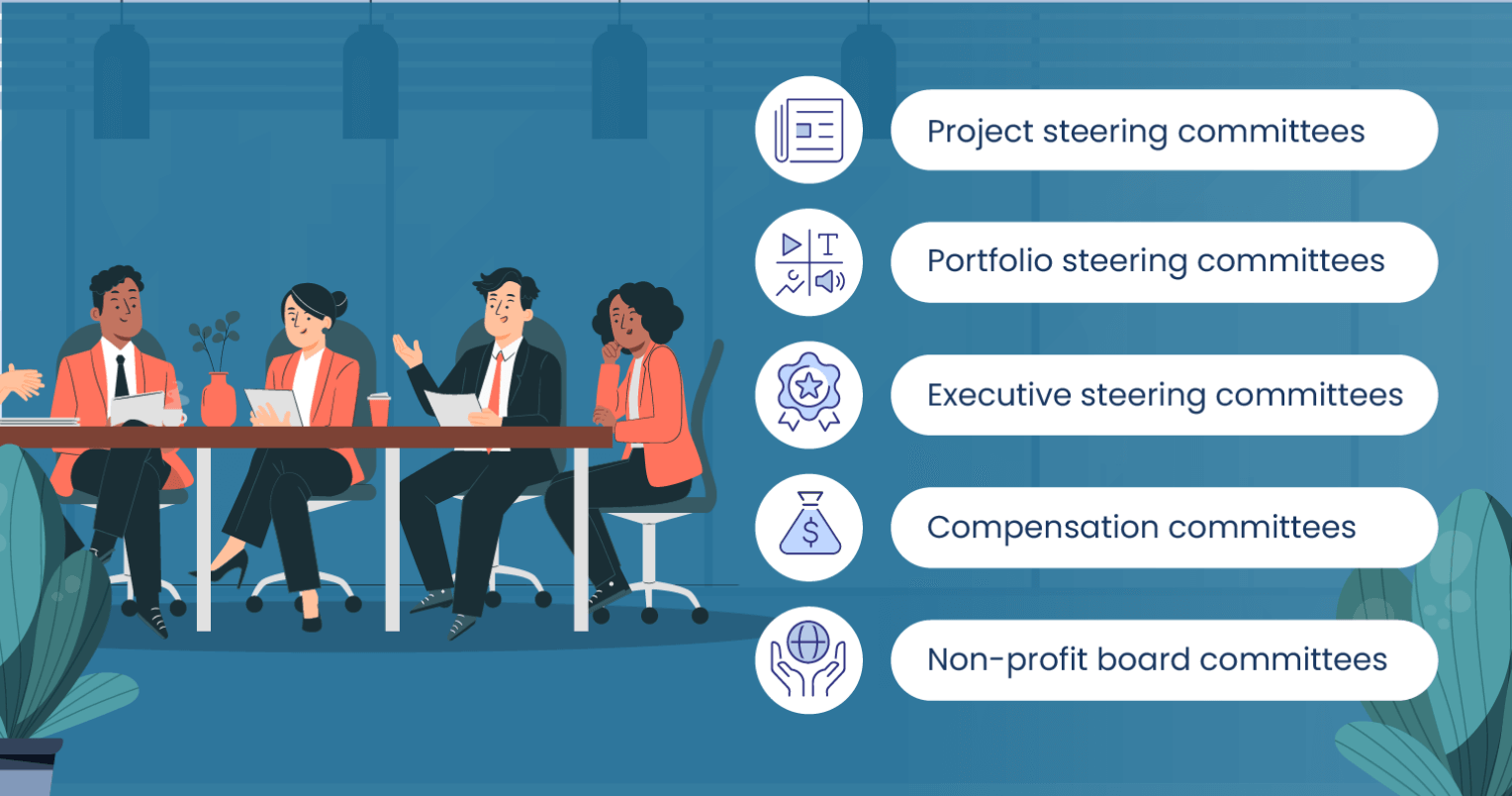Every business understands the importance of staying on track in any endeavor — may it be creating a new IT system or launching a new product. To ensure that such projects deliver the intended results, having a steering committee is a good solution. Usually comprised of key stakeholders and experts, this committee acts as a guiding hand in project management and risk mitigation.
In this guide, we will explore the steering committee definition, its role and responsibilities, and the best practices to run one.
What is a steering committee?
A steering committee functions as a specialized team responsible for governance over a project or campaign. This advisory board primarily provides high-level oversight and strategic direction with a vested interest in the project’s success and makes sure it aligns with broader organization goals. In general, the committee’s main concerns are the direction, scope, timeliness, budget, and methods involved in the project.
How does a steering committee differ from a board committee?
While both steering committees and board committees play vital roles in organization governance, there are some key distinctions between them. These include:
| Steering Committee | Board Committee | |
|---|---|---|
| Purpose | Primarily focuses on guiding specific projects by providing strategic direction and monitoring progress. | Handles specific areas of responsibility within the organization, such as audit committees and risk management committees. |
| Scope | Manages a single project or small group of related initiatives within a defined timeframe. Their scope is more focused and narrower. | Has a broader scope, overseeing various aspects of the organization’s operations on an ongoing basis. |
| Composition | Can be comprised of individuals from various departments, such as project managers and subject-matter experts. | Consists of board members, with potential inclusion of external experts depending on the committee’s mandate. |
Overall, a steering committee is more of a temporary and project-specific entity, while a board committee is a more permanent fixture within the organization structure.
Who is on a steering committee?

The steering committee’s purpose often determines who its members are. While its composition varies depending on the specific steering committee purpose or project, it generally includes a mix of:
- Senior stakeholders — These involve C-suite executives, such as CEO, CFO, and COO, who have a vital interest in the project’s success.
- Department heads — Including a department head relevant to the project ensures proper alignment with department objectives and resource allocation within teams. To put it simply, having the Head of Marketing on the committee, for instance, is essential if the project requires a new marketing strategy.
- Subject matter experts (SMEs) — These individuals have deep knowledge and expertise in the project’s specific area. Their technical understanding helps assess feasibility and identify potential risks, which makes them valuable assets.
- External representatives — Typically optional, external stakeholders might be included depending on the project scope. These may include consultants, academic researchers, industry association representatives, or even community leaders (to provide input on the project’s potential impact on the local community). For instance, managing a project involving a collaboration with a supplier might require a representative from their company. This enables suppliers to share their perspectives and requirements for the project.
What does a steering committee do?
In a nutshell, a steering committee provides an expert, objective standpoint when making decisions on a project. They make sure the project is right on track, from the deliverables to the processes involved. While their role revolves around monitoring projects, they closely collaborate with a project manager and a team to get the work done. Besides strategic direction and oversight, their primary responsibilities include:
- Prevent conflicts, and resolve them once they occur
- Advocate the projects across the company and even in external spaces
- Manage deviations and risks to the project scope that can impact success
- Serve on panel meetings relevant to the project under implementation
Different Types of Steering Committees

The type of steering committee to set up highly depends on the needs of the business. Below are the common types of steering committees and their purposes.
1. Project steering committees
A project steering committee, among the most common types, is formed to supervise a single, specific project. Hence, making their involvement and existence dependent on the project’s lifecycle or completion. They also work with a project manager to ensure they have support in the project’s progress, risks, and resources.
2. Portfolio steering committees
While project steering committees are temporary, portfolio steering committees are permanent. These advisory boards are created for monitoring an entire portfolio of company projects. They also have the authority to approve new projects and priorities for each. Since they oversee a collection of projects, they often utilize sub-committees for specialized expertise or individual projects.
What’s the difference between project steering committees and portfolio steering committees?
Imagine an educational institution with multiple ongoing research projects. A project steering committee will handle a specific research project, for instance, developing a new solar energy technology. On the other hand, a portfolio steering committee would have a broader view, such as allocating funding across various projects (e.g. solar energy, social sciences, bioengineering).
3. Executive steering committees
This type of steering committee is usually composed of the company’s executive director, and/or top executives (CEO, CFO, COO). Executive steering committees are formed to provide high-level strategic oversight, especially for crucial initiatives. However, they do not have the final say like a formal executive board. Some key differences between an executive steering committee and an executive board are:
- Authority: The steering committee is advisory in nature, while the board has final decision-making power.
- Scope: An executive steering committee may still focus on specific projects or campaigns, while an executive board deals with the entire company’s direction.
- Composition: Steering committees have more flexibility in membership, while executive boards typically maintain a more formal structure.
4. Compensation committees
The compensation committee, as its name suggests, manages anything related to an organization’s compensation. One of its functions is to develop and oversee company-wide compensation policies, including salary structures, benefits packages, bonus programs, and stock options.
Additionally, the committee also analyzes internal data on employee performance, compensation levels, and turnover rates. In terms of compliance, they also ensure all compensation decisions are fair and non-discriminatory. Overall, their job is to ensure the company’s compensation offerings remain relevant to the job market, following equal pay regulations.
5. Non-profit board committees
The primary job of a non-profit committee is to create strategic plans and manage projects with tight budgets. They may provide oversight of financial forecasting and risk management processes, working with the board treasurer or external auditors (if necessary).
And since non-profits deal with limited resources, this committee is set up to develop fundraising strategies. They cultivate relationships with donors and explore diverse fundraising avenues (e.g. sponsorships, events, grants).
Common Challenges Faced by a Steering Committee

Steering committees are primarily set up to guide projects toward success. However, several challenges can hinder their effectiveness, which include:
1. Conflicting interests
Steering committees are made up of cross-functional representatives, often people with strong personalities and different opinions or interests. Such facets can intersect with the best interests of the project and eventually, hinder objective decision-making.
Solutions:
- Encourage data-driven decision-making based on project goals and impact analysis.
- Establish a clear prioritization framework that touches on factors like strategic alignment and financial feasibility.
2. Lack of clarity in roles
Confusion about steering committee roles and responsibilities is a common issue among members. Plus, there are project managers and other teams a steering committee must also work with. Lack of clarity in steering committee roles and responsibilities can lead to disrupted project timelines and unfinished tasks. Such confusion on accountability for tasks may also lead to duplication of efforts and overall inefficiency.
Solutions:
- Have a role clarification matrix that clearly defines the steering committee roles and responsibilities of everyone involved in the project.
- Delegate specific tasks to steering committee members based on their expertise and experience.
3. Communication gaps
Poor communication is a common problem for any kind of team, which often leads to information silos within the committee. Instances can happen when members are not aware of project updates, decisions made outside of meetings, or concerns raised by stakeholders. Unclear communication routes can cause misunderstandings and hinder collaboration.
Solutions:
- Have regular communication channels to ensure information flow, keeping every member updated. Set up frequent email updates, committee meetings, or designated points of contact.
- Circulate meeting agendas and minutes promptly, including action items and deadlines.
Best Practices to Run an Effective Steering Committee

Having an effective steering committee can significantly benefit a project’s performance. To guarantee project success, here are some best practices to create a well-functioning committee.
1. Establish a formal steering committee charter
Having a well-defined charter can serve as the committee’s foundation. Ideally, it should outline the steering committee’s purpose, scope of authority, composition, and meeting structure. Overall, the steering committee charter acts as a roadmap for the committee’s activities and helps maintain alignment with goals.
2. Assemble the right people
A steering committee doesn’t always need the highest-ranking people, but instead those with the right expertise, experience, and diverse perspectives. Generally, steering committee members should include technical experts who represent different departments, stakeholders, and upper-level management. Also, including individuals from diverse backgrounds (gender, race, thought processes) can foster a richer discussion and lead to more comprehensive decision-making.
3. Utilize subcommittees effectively
Having subcommittees that can delve deeper into specific areas of a project can be helpful too. Subcommittees can offload detailed, specific work, allowing the main committee to focus on high-level decisions. To ensure effectiveness, give them clear mandates, timelines, and reporting mechanisms.
4. Know the committee’s personality
No steering committees are ever alike, especially when it comes to their leadership and decision-making styles. Some might function best with a senior leader who can take charge during discussions and decisions. Others work better with a more collaborative approach, wherein decisions are reached through consensus building.
5. Foster balanced collaboration and conflict resolution
A well-functioning steering committee encourages collaborative participation from everyone. Create a safe space for open discussion and diverse perspectives. Also, develop clear processes for addressing conflicts or disagreements (e.g. establishing voting system and rights, using objective evidence to reach decisions).
6. Keep meetings productive
Effective and productive meetings play a critical role in how the committee functions and makes decisions. Set clear agendas aligned with the charter, enforce time limits, and assign proper action items with deadlines to designated owners. After all, meetings are valuable time investments for the entire company, so make them count.
Convene: Helping You Run Your Steering Committee Successfully

Guiding projects and navigating other complexities of committee management can be daunting. Juggling all these responsibilities alongside core job functions can even leave members overwhelmed. This is where board portals step in.
Convene, a leading board portal solution, understands the need for a streamlined decision-making process and successful project execution. Convene’s suite of features includes:
- Live Meeting Tools: Allows committee members to collaborate, discuss, and refine ideas together.
- Action Item Management: Hold steering committees accountable and ensure tasks are done on time with clear action item tracking.
- Agenda Builder: Save time using Convene’s Agenda Builder for creating and managing clear, focused agendas.
- Centralized Dashboards: Convene’s customizable dashboards enable steering committees to gain real-time insights into project progress and KPIs.
- Secure Document Management: Convene’s Document Management system allows steering committees to centralize all materials in a secure environment with version control functionality too.
Want to learn more about how Convene can empower steering committees? Talk to our team and request a demo now!
Jielynne is a Content Marketing Writer at Convene. With over six years of professional writing experience, she has worked with several SEO and digital marketing agencies, both local and international. She strives in crafting clear marketing copies and creative content for various platforms of Convene, such as the website and social media. Jielynne displays a decided lack of knowledge about football and calculus, but proudly aces in literary arts and corporate governance.


![How to Create a Board Skill Matrix + Template [Free Download]](https://cdn.azeusconvene.com/wp-content/uploads/2024Q3_Jul_Board-of-Directors-Skills-Matrix-Whitepaper-C-Dark.png)








